2023 Kia Sportage PHEV Hybrid System And Charging the Plug-in Hybrid Vehicle System
The 2023 Kia Sportage PHEV and HEV are a big step into the future of car technology. They combine speed and sustainability in a way that works well for everyone. These cutting-edge models have both hybrid and plug-in hybrid electric vehicle (PHEV) systems built in. This shows that Kia is committed to making cars that are better for the environment. With their innovative powertrains, these Sportage models let drivers choose between electric and gasoline power, which cuts down on pollution and fuel use while still providing great performance. Advanced regenerative braking systems and energy management are also built in to ensure the highest level of economy. The most important part of this eco-friendly driving experience is the PHEV’s charging features, which make it easy for drivers to plug in and charge their batteries. In this time of environmental awareness, the 2023 Kia Sportage PHEV and HEV Systems and Charging offer an interesting glimpse into the future, where eco-friendliness and style come together to change the way we drive.
2023 KIA SPORTAGE Specs, Price, Features and Mileage (Brochure)
Hybrid System Overview
PHEV (Plug-in Hybrid Electric Vehicle) System
The Kia Plug-in Hybrid Electric Vehicle (PHEV) shares the characteristics of both a conventional hybrid electric vehicle and an all-electric vehicle.
When used as a conventional hybrid electric vehicle, the HEV computer selectively operates between the engine and the electric motor or even both at the same time.
When it is operating in the electric vehicle mode, the vehicle is driven only using the electric motor over a certain distance until the hybrid battery becomes low. The driving distance in EV mode depends on the customer’s driving style and road conditions. Aggressive driving maneuvers may at times temporarily enable the engine to operate.
The engine power could be limited during the emission reduction control period at cold engine conditions. The hybrid battery can be fully charged by connecting a plug to an external electric power source. An engine can be turned on due to factors such as a heater and the frequent operation of the accelerator pedal by a driver in CD mode.
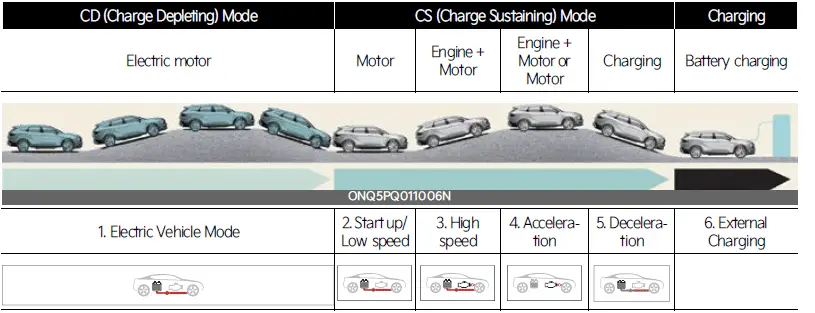
HEV (Hybrid Electric Vehicle) System
The Kia Hybrid Electric Vehicle (HEV) uses both the gasoline engine and the electric motor for power. The electric motor is run by a high-voltage HEV battery. Depending on the driving conditions, the HEV computer selectively operates between the engine and the electric motor or even both at the same time. Fuel efficiency increases when the vehicle is driven by the electric motor with the HEV battery. The HEV battery charge must be maintained, so at times the engine will come on even at idle to act as a generator. Charging also occurs when decelerating or by regenerative braking.
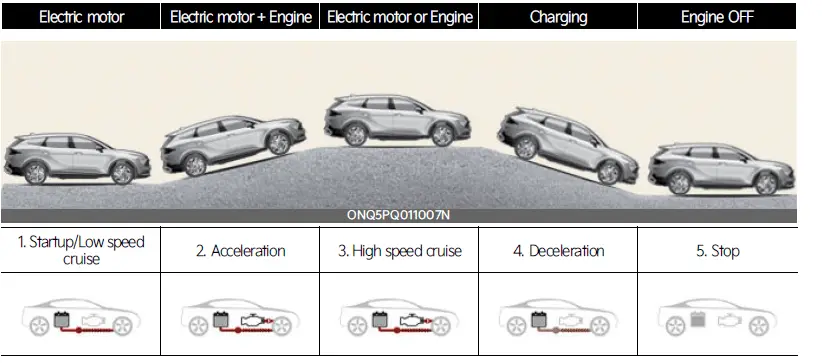
2023 Kia Sportage Plug-in Hybrid Charging
Charging Information
AC Charger: The plug-in hybrid vehicle is charged by plugging into a AC charger installed in your home or a public charging station.
- Trickle Charger: The plug-in hybrid vehicle can be charged by using household electricity.
The electrical outlet in your home must comply with regulations and can safely accommodate the Voltage/Cur-rent (Amps)/Power (Watts) ratings specified on the trickle charge. Use only as a backup charger.
Charging Time
- AC Charger: Takes about 1 hour 40 minutes at room temperature (Can be charged to 100%.). Depending on the condition and durability of the high-voltage battery, charger specifications, and ambient temperature, the time required for charging the high-voltage battery may vary.
- Trickle Charger: For charging at home. Please note that the Trickle Charger is slower than the AC Charger.
Charging Types

- Depending on the condition and durability of the high-voltage battery, charger specifications, and ambient temperature, the time required for charging the high voltage battery may vary.
- Actual charger image and charging method may vary in accordance with the charger manufacturer.
Charging status
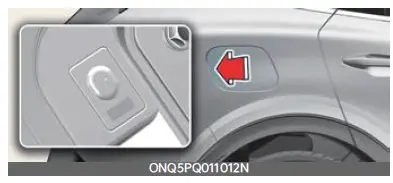
You can check the charging status at the outside of the vehicle when charging or using (it is not driving status) the high-voltage battery. It takes about 2 ~ 3 hours or more to complete charging.
| Classification | Details | Operation of charging indicator lamp | |||
| Mode | Status | Charging inlet | Charging button | ||
| A | READY | Non-charging state | 0 ~ 65 % | On (Yellow) | Off |
| 65 ~ 100 % | On (Green) | Off | |||
| B | Aux. Battery Saver/High volt-
age warning |
Charging the 12V auxiliary battery / High-voltage
warning state |
On (Red) | Off | |
| C | Charging | Charging | 0 ~ 65 % | Blinking (Yellow) | Off |
| 65 ~ 100 % | Blinking (Green) | Off | |||
| D | Charging complete | Charging completed (turns off
in 5 seconds) |
100 % | On (Green) > OFF | Off |
| E | Charging failed | Error while charging | Blinking (Red) | Off | |
| F | Scheduled charging standby | Reserved charging is operating (turns OFF after
3 minutes) |
Off | On | |
| G | Error | CAN communication error status | On (Green) > On (Orange) > On
(Red) |
Off | |
Checking charging status

You can check the charging status at the outside of the vehicle when charging or using (it is not driving status) the high-voltage battery. It takes about 2 ~ 3 hours or more to complete charging.
AC charging connector lock
This AC charging connector lock function prevents an outsider from removing the charging connector from the charging inlet.
Connector lock
| Always lock | Lock while charging | Do not lock Mode | |
| Before
charging |
O | X | X |
| While
charging |
O | O | X |
| After
charging |
O | X | X |
Always lock
The connector locks when the charging connector is plugged into the charging inlet. The connector is locked until all doors are unlocked by the driver. This mode can be used to prevent charging cable theft.
- If the charging connector is unlocked when all doors are unlocked, but the charging cable is not disconnected within 15 seconds, the connector will be automatically locked again.
- If the charging connector is unlocked when all doors are unlocked, but all doors are locked again, immediately, the connector will be automatically locked again.
Lock while charging
The connector locks when charging starts. The connector unlocks when charging is complete.
Do not lock
The locking device for charging inlet is kept unlocked regardless of the charging status. The locking device is kept unlocked during charging and you can separate the connector by pressing the button of the charging connector. Please be careful about the potential theft of the charging cable when selecting this mode.
Scheduled charging
- You can set reserved charging using the infotainment system. Refer to the infotainment system for detailed information about setting reserved charging.
- Scheduled charging can only be done when using a AC charger or the portable charging cable (ICCB: In-Cable Control Box).
- When scheduled charging is set and the AC charger or the portable charging cable (ICCB: In-Cable Control Box) is connected for charging, the scheduled charge release button is illuminated (for 3 minutes) to indicate that scheduled charging is set.
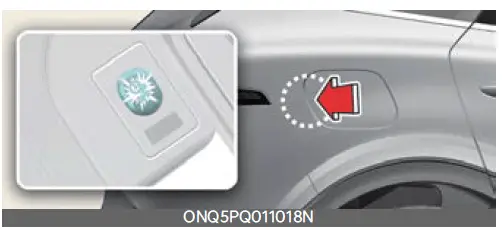
- When scheduled charging is set, charging is not initiated immediately when the AC charger or portable charging cable (ICCB: In-Cable Control Box) is connected.
- If charging is required immediately, turn off the scheduled charge using the infotainment system or press the vehicle’s scheduled charge release button () more than 2 seconds.
- When the scheduled charge is set, the charge start time is calculated by itself. In some cases, charging may start immediately after connecting the charger.
- If you press the scheduled charging deactivation ( ) button to immediately charge the battery, charging must be initiated 3 minutes after the charging cable has been connected.
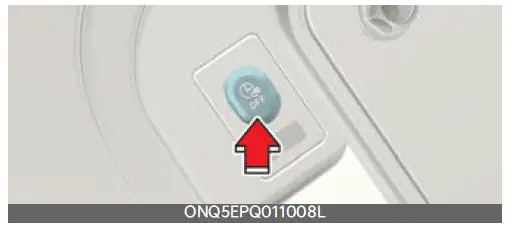
When you press the scheduled charging deactivation ( ) button for immediate charging, the scheduled charge setting is not completely deactivated. If you need to completely deactivate the scheduled charge setting, use the infotainment system to finalize the deactivation.
Charging precautions
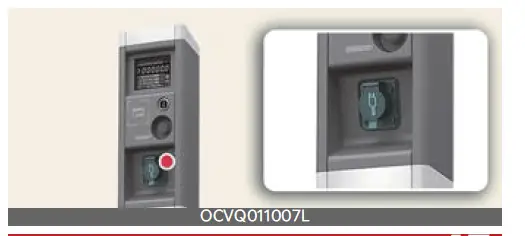
WARNING
Fires caused by dust or water
Do not connect the charging cable connector plug to the vehicle if there is water or dust on the charging inlet. Connecting while there is water or dust on the charging cable connector and plug may cause a fire or electric shock. There may be a risk of fire and injury when using old worn-out public electrical outlets.
WARNING
Old or Worn out Electric Outlets
Do not use old or worn-out electric outlets to charge your vehicle. There may be a risk of fire and injury when using old worn-out public electrical outlets.
WARNING
Interference with electronic medical devices
When using medical electric devices such as an implantable cardiac pacemaker, make sure to ask the medical team and manufacturer whether charging your electric vehicle will impact the operation of the medical devices. In some instances, electromagnetic waves that are generated from the charger can seriously impact medical electric devices such as implantable cardiac pacemakers.
WARNING
touching the charging connector
Do not to touch the charging connector, charging plug, and the charging inlet when connecting the cable to the charger and the charging inlet on the vehicle. Doing so may result in electrocution.
- Comply with the following in order to prevent electrical shock when charging:
- Use a waterproof charger Make sure to not touch the charging connector and charging plug when your hand is wet
- Do not charge when there is lightning
- Do not charge when the charging connector and plug is wet
WARNING
Charging cable
- Immediately stop charging when you find abnormal symptoms (smell, smoke).
- Replace the charging cable if the cable coating is damaged to prevent electrical shock.
- When connecting or removing the charging cable, make sure to hold the charging connector handle and charging plug. If you pull the cable itself (without using the handle), the internal wires may disconnect or get damaged. This may lead to electric shock or fire.
WARNING
Cooling fan
Do not touch the cooling fan while the vehicle is charging. When the vehicle is switched OFF while charging, the cooling fan inside the motor compartment may automatically operate.
WARNING
Make sure to use the designated charger for charging the vehicle. Using any other charger may cause failure or lead to electric shock or fire.
- Always keep the charging connector and charging plug-in clean and dry condition. Be sure to keep the charging cable in a condition where there is no water or moisture.
- Make sure to use the designated charger for charging the vehicle. Using any other charger may cause failure.
- Before charging the battery, turn the vehicle OFF.
- Be careful not to drop the charging connector. The charging connector can be damaged.
- Always inspect the charging connector terminals for damage or overheating. Do not use if damaged, as this may damage the vehicle side charge connector and is not a warrantable repair.
AC charger
AC Charger
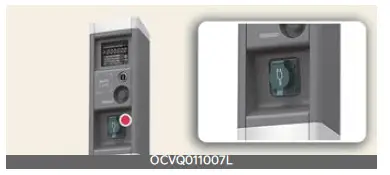
AC charger cable
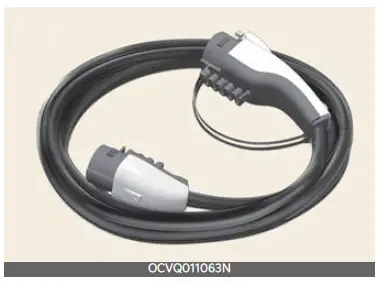
You can charge your vehicle by plugging into a public charger at a charging station.
How to connect AC charger
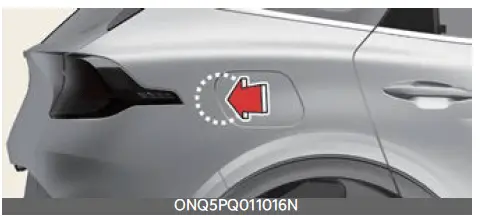
- Depress the brake pedal and apply the parking brake.
- Turn OFF all switches, move the shift dial to P (Park), and turn OFF the vehicle.
- Open the charging door by pressing rear centre edge of the charging door.
- Remove any dust on the charging connector and charging inlet.
- Hold the charging connector handle.
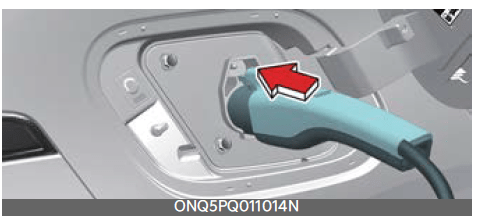
Then, insert the charger into the charging inlet, until you hear a click sound. If it is not fully connected, a bad connection between the charging connector and the charging terminals may cause a fire. - Check if the charging cable connection indicator( ) of the high voltage battery in the instrument cluster is turned ON. Charging does not occur when the indicator is OFF. When the charging connector is not connected properly, reconnect the charging cable to charge.
NOTICE
- The charging is in progress only with the shift dial is in P (Park). Charging the battery with the ENGINE START/STOP button in the ACC position is possible. However, it may discharge the 12-V battery. Thus, if possible, charge the battery with the ENGINE START/STOP button in the OFF position.
- Moving the shift dial from P (Park) to R (Reverse)/N (Neutral)/D (Drive) stops the charging process. To restart the charging process, move the shift dial to P (Park), press the ENGINE START/STOP button to the OFF position, and disconnect the charging cable. Then, connect the charging cable.
Charging connector lock mode
When the charging connector is plugged into the charging inlet, the connector lock timing varies with the modes selected by the user settings menu or the infotainment screen menu.
- Always lock: The connector locks when the charging connector is plugged into the charging inlet.
- Lock while charging: The connector locks when charging starts. The connector unlocks when charging is completed.
- Do not lock: The locking device for the charging inlet is kept unlocked regardless of the charging status.
How to disconnect AC charger
- The vehicle doors must be unlocked in order to be able to disconnect the charging connector. A lock system prevents charger cable disconnection when the vehicle’s doors are locked.
NOTICE
In order to disconnect the charging connector, unlock the doors to unlatch the charging connector lock system. If not, the charging connector and the vehicle’s charging inlet may be damaged. - =Hold the charging connector hand eland pull it out.
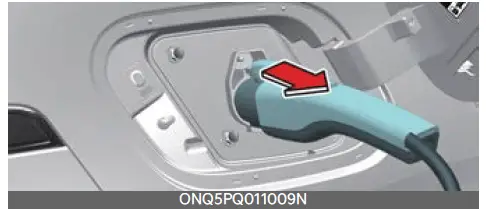
To prevent charging cable theft, the charging connector cannot be disconnected from the inlet when the doors are locked.
However, if the vehicle is in the charging connector AUTO mode, the charging connector automatically unlocks from the inlet when charging is completed.
If the connector is not automatically unlocked after charging is completed in AUTO mode, the connector is unlocked when all of the doors are unlocked.
NOTICE
When disconnecting the charging connector, do not try to disconnect it by force while not pressing the release button. This may damage the charging connector and vehicle charging inlet.
Close the charging door by pressing the rear center edge of the charging door.* The charging door does not have a locking system.
WARNING
Do not modify or disassemble the charging cable components. It may cause a fire or an electric shock with personal injury.
NOTICE
- If you cannot open the charging door due to freezing weather, tap lightly or remove any ice near the charging door. Do not try to forcibly open the charging door. If you open it by force, the charging door may be damaged.
- Keep the charging connector and the charging plug clean and dry. The charging cable should be also kept dry.
- Use an air gun to blow any foreign substances from the charging connector and the charging plug.
2023 KIA SPORTAGE Specs, Price, Features and Mileage (Brochure)
Trickle charger (portable charging cable)
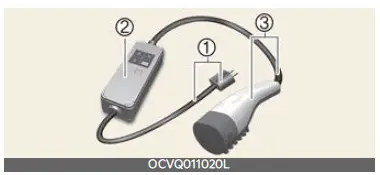
Trickle charger can be used if AC Charger is unavailable.
- Plug and cable
- Control box (ICCB)
- Charging connector/cable
How to connect the portable charger (ICCB: In-Cable Control Box)
- Turn OFF all switches, move the shift dial to P (Park), and turn OFF the vehicle.
- Connect the plug to a household electric outlet.
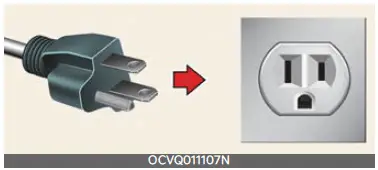
- Check if the power lamp (green) illuminates on the control box.
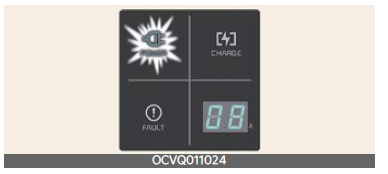
- Depress the brake pedal and apply the parking brake.
- Turn OFF all switches, shift to P (Park), and turn OFF the vehicle. If charging is initiated without the gear in P (Park), the charging will start after the gear is automatically shifted to P (Park).
- Open the charging door.
- Open the protection caps of the charging connector and the charging plug. Check if there are any foreign substances or dust.
- Hold the charging connector handle and connect it to the vehicle charging inlet. Push the connector all the way in. If the charging connector and charging terminal are not connected properly, this may cause a fire.
- Charging starts automatically (charging lamp illuminates).

- Check if the charging indicator light ( ) of the high voltage battery in the instrument cluster is turned ON. Charging is not active when the charging indicator light ( ) is OFF. When the charging connector is not connected properly, reconnect the charging cable to charge it again.
- After charging has started, the estimated charging time is displayed on the instrument cluster for about 1 minute.
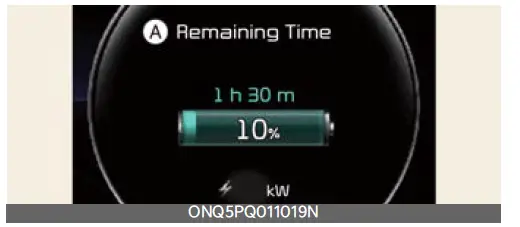
A: Remaining Time
If you open the driver seat door while charging, the estimated charging time is also displayed on the instrument cluster for about 1 minute. When scheduled charging or scheduled air conditioner/heater is set, the estimated charging time is displayed as “–“.
Charging cable storage

We recommend that the trickle charger cable should be put in the storage box after use.
Charging status indicator lamp for portable charger
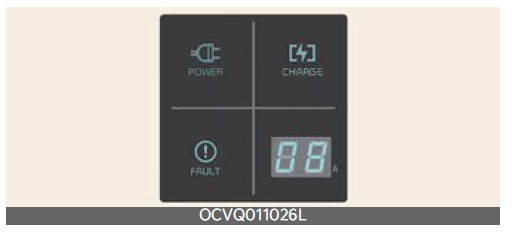
| Indicator | Details | |
| POWER | On: Power on | |
| CHARGE | On: Charging
Blink: Current limit due to high plug temperature or high internal temperature |
|
| FAULT | Blink: Charging interrupted | |
| CHARGE LEVEL | 12 | 12 A |
| 10 | 10 A | |
| 08 | 8 A | |
| 06 | 6 A | |
| The charging current changes whenever the button (1) is pressed for less than 1 sec with the charger plugged into an electrical outlet but not the vehicle.
Control box
OCVQ011021L |
||
Status/Diagnosis/Countermeasure

- Charging connector plugged into vehicle (POWER Green ON)
- Plug connected to an electric outlet (POWER Green ON)
While charging

- Charge indicator (POWER Green ON/ CHARGE Blue ON)
- Charging current
Before plugging the charging connector into the vehicle (POWER Green ON, FAULT Red blink)
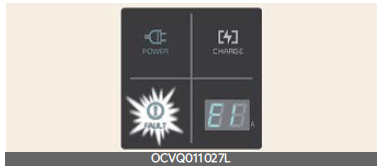
- Abnormal temperature
- ICCB (In-Cable Control Box) failure
Plugged into the vehicle (POWER Green ON, FAULT Red Blink
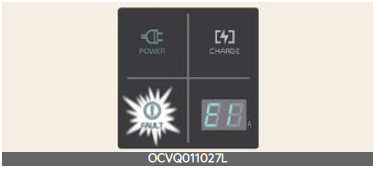
- Diagnostic device failure
- Current leakage
- Abnormal temperature
Leakage current failure (POWER Green ON, FAULT Red Blink)
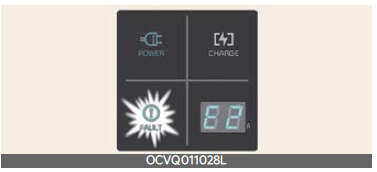
- After disconnecting and reconnecting the power plug, press and release the button for 2 seconds or longer to clear the error.
Power saving mode
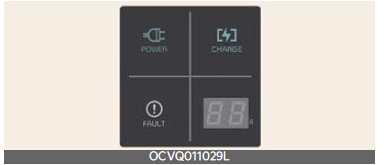
- Charge level indicator is turned off if there is no status change for more than 1 minute.
How to disconnect portable charging cable (ICCB: In-Cable Control Box)
- Before disconnecting the charging connector, make sure the doors are unlocked. When the door is locked, the charging connector lock system will not allow disconnection. To pre-vent charging cable theft, the charging connector cannot be disconnected from the inlet when the doors are locked. However, if the vehicle is in the charging connector AUTO mode, the charging connector automatically unlocks from the inlet when charging is completed.
NOTICE
In order to disconnect the charging connector, unlock the doors to unlatch the charging connector lock system. If not, the charging connector and the vehicle’s charging inlet may be damaged. - Hold the charging connector hand lead pull it out.

- Make sure to securely close the charging door.
- Disconnect the plug from the household electric outlet. Do not pull the cable when disconnecting the plug.
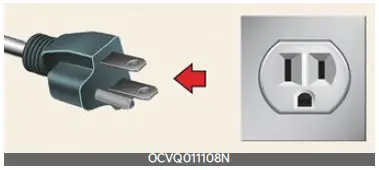
- Close the protective cover for the charging connector so that foreign material cannot get into the terminal.
- Put the charging cable inside the cable compartment to protect it.
Precautions for portable charging cable (ICCB: In-Cable Control Box)
- Use the portable charging cable that is certified by Kia.
- Do not try to repair, disassemble, or adjust the portable charging cable.僅 Do not use an extension cord or adapter.
- Stop using it immediately if the failure warning light occurs.
- Do not touch the plug and charging connector with wet hands.
- Do not touch the terminal part of the AC charging connector and the AC charging inlet on the vehicle.
- Do not connect the charging connector to voltage that does not comply with regulations.
- Do not use the portable charging cable if it is worn out, or exposed, or there exists any type of damage on the portable charging cable.
- If the ICCB case and AC charging connector is damaged, or cracked, or the wires are exposed in any way, do not use the portable charging cable.
- Do not let children operate or touch the portable charging cable.
- Keep the control box free of water.
- Keep the AC charging connector or plug terminal free of foreign substances.
- Do not step on the cable or cord. Do not pull the cable or cord and do not twist or bend it.
- Do not charge when there is lightning.
- Do not drop the control box or place a heavy object on the control box.
- Do not place an object that can generate high temperatures near the charger when charging.
- Charging with a worn-out or dam-aged household electric outlet can result in a risk of electric shock. If you are in doubt to the household electric outlet condition, have it checked by a licensed electrician.
- Stop using the portable charging cable immediately if the household electric outlet or any components is overheated or you notice burnt odors.
Actions to be taken for electric vehicle charging issues
When you cannot charge the high-voltage battery after connecting the charger, check the following:
- Check the charging settings for the vehicle. (e.g. when scheduled charging is set, charging is not initiated immediately when the AC charger or portable charger is connected.)
- Check the operation status of the AC charger and portable charger. (Status of portable charger)
* The actual method for indicating the charging status may vary in accordance with the charger manufacturer. - When the vehicle does not charge and a warning message appears on the instrument cluster, check the corresponding message.
- If the vehicle is properly charged when charged with another normally working charger, contact the charger manufacturer.
- If the vehicle does not charge when charged with another normally working charger, have your vehicle inspected by an authorized Kia dealer.
How to disconnect the charging connector in an emergency

If the charging connector does not disconnect due to battery discharge and/or failure of the electric system, open the luggage board (1), remove the storage box and slightly pull the emergency cable (2). The charging connector will then disconnect.
FAQs
What is a PHEV (Plug-in Hybrid Electric Vehicle)?
An internal combustion engine (ICE), an electric motor, and a large battery make up a PHEV, a type of hybrid vehicle. It can be charged using an external power source, extending the range of an electric vehicle.
What is an HEV (Hybrid Electric Vehicle)?
A hybrid electric vehicle (HEV) uses both an electric motor and an internal combustion engine. HEVs rely on regenerative braking and the internal combustion engine to charge the battery, unlike PHEVs which have a plug-in charging feature.
What is the advantage of owning a PHEV?
A PHEV has the benefit of a longer electric driving range, which lowers fuel use and emissions. It makes driving more environmentally friendly while preserving the option to use gasoline for longer distances.
How does regenerative braking work in a PHEV?
When braking or decelerating, regenerative braking converts kinetic energy into electrical energy. The battery of the car is then recharged using this energy, increasing overall efficiency and extending the electric driving range.
Can I charge the Kia Sportage PHEV from a standard household outlet?
Yes, it is possible to use Level 1 charging to charge the Kia Sportage PHEV using a regular household outlet. Level 1 charging is typically used for overnight charging, but it is slower than other methods.
What is Level 2 charging?
A 240-volt charging station is necessary for Level 2 charging, which offers quicker charging times than Level 1 charging. It is frequently used for daily charging needs and is perfect for home installation or public charging stations.
How long does it take to charge the Kia Sportage PHEV using Level 2 charging?
The starting battery level and the onboard charger’s capacity can affect how long it takes to charge using Level 2 charging. The Sportage PHEV can be fully charged in an average of 3–4 hours.
What is DC Fast Charging?
Direct current (DC) is delivered to the vehicle’s battery via DC Fast Charging, a high-power charging option that enables quick charging. Depending on the power output of the charging station, it is frequently accessible at some public charging stations and can provide up to 80% charge in roughly 30 minutes.
Can I use DC Fast Charging for everyday charging?
While DC Fast Charging offers quick charging times, it is only advised for sporadic use or in situations where fast charging is required, such as on lengthy trips. The lifespan of the battery may be impacted by routine DC Fast Charging use.
How do I locate public charging stations for my Sportage PHEV?
Numerous smartphone applications and online resources offer up-to-date details on nearby charging stations, including their availability and appropriate connector types. Planning your routes and finding charging stations while on the go is made simpler by these apps.
Can I charge my Sportage PHEV at any public charging station?
If the charging connectors are compatible, the Sportage PHEV can be charged at the majority of public charging stations. Before charging, it’s crucial to confirm the connector type and any other requirements for the station.
Can I install a Level 2 charging station at home?
You can set up a Level 2 charging station at home, yes. Kia offers advice and support for home charging solutions, but professional installation is advised to ensure secure and effective charging.
What is the electric driving range of the Kia Sportage PHEV?
Several variables, including road conditions, battery charge, and driving habits, can affect the Kia Sportage PHEV’s electric driving range. The Sportage PHEV can achieve an electric range of roughly 30 to 40 miles on average.
Can I use a Level 1 charging cable with a Level 2 charging station?
No, charging cables for levels 1 and 2 cannot be used interchangeably. While Level 2 charging stations need a specific connector and higher voltage, Level 1 charging cables are made for regular household outlets.
How do I access the charging port on the Sportage PHEV?
The Sportage PHEV’s charging port is typically found outside the car, usually on the front or rear fender. It is simple to use and designed to connect quickly to charging stations and cables.
How to Charge Kia Sportage Hybrid?
To charge the Kia Sportage Hybrid, plug the charging cable into the charging port located on the vehicle, and connect the other end to a compatible electric charging station or wall outlet. Monitor the charging status through the vehicle’s display panel.
Useful Link
View Full User Guide: Kia Sportage PHEV 2023 User Guide | Auto User Guide
Download Manuals: https://owners.kia.com/content/owners/en/manuals.html
2023 KIA SPORTAGE Specs, Price, Features and Mileage (Brochure)

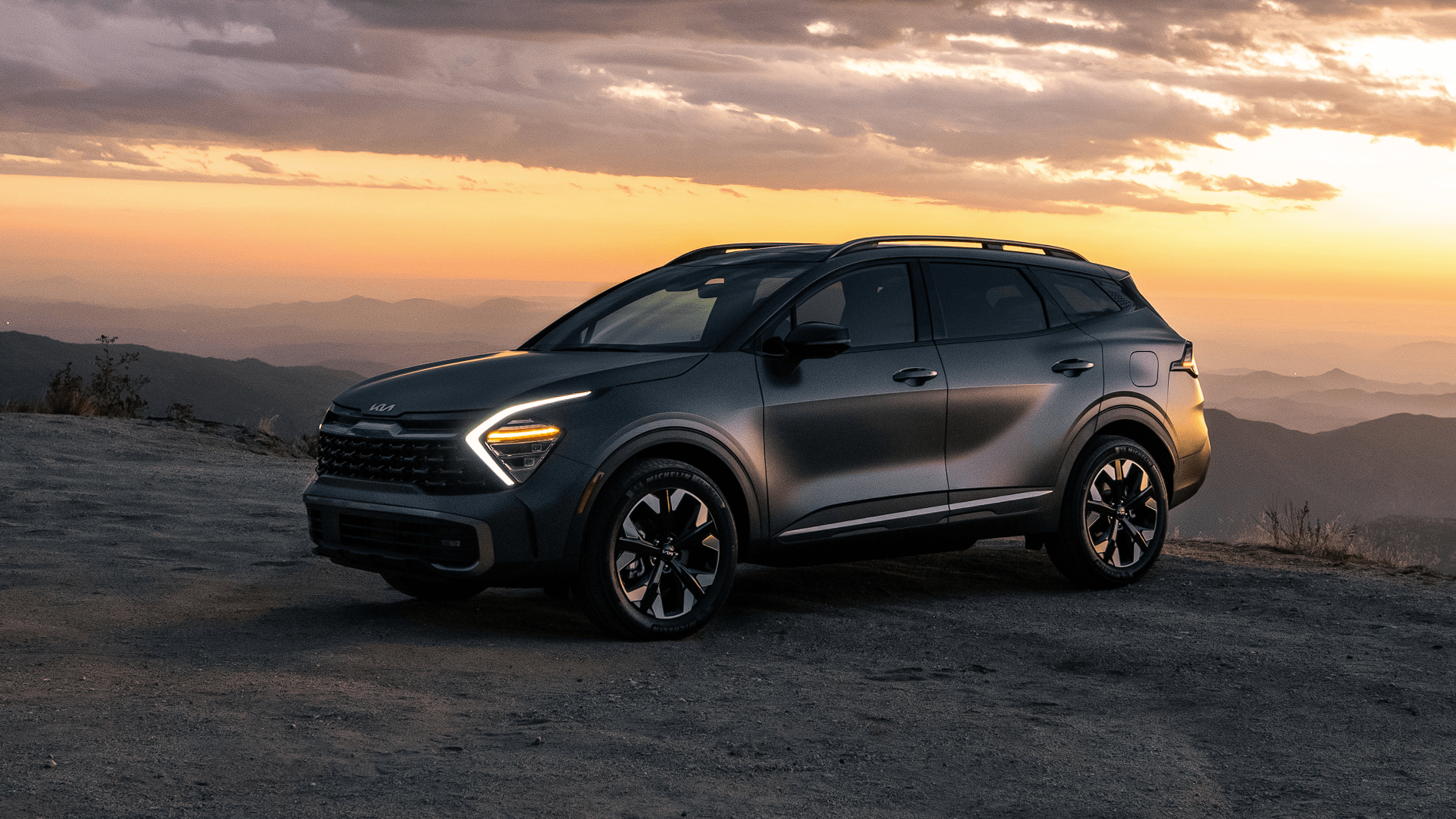

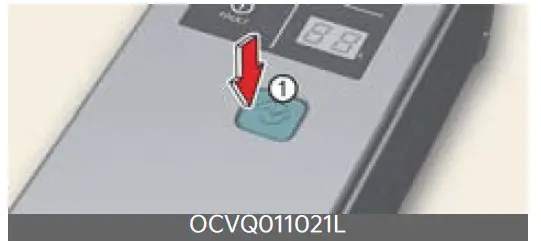
One reply on “2023 Kia Sportage PHEV, HEV Systems and Charging User Guide”
Trying to get all the information I can while awaiting my Sportage PHEV. Excellent article.